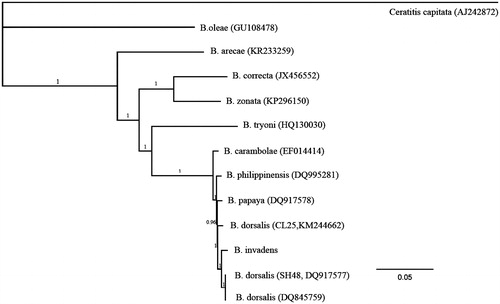Abstract
In this study, the complete 15,911 bp mitochondrial genome (mitogenome) of Bactrocera invadens was sequenced. To estimate the status of B. invadens, all available mitogenomes of Bactrocera were downloaded from GenBank for phylogenetic analysis. Phylogenetic analyses showed that B. invadens, B. philippinensis, B. papayae, and three B. dorsalis sequences formed a well-supported clade with very short terminal branch lengths, indicting the relatively close evolutionary relationships of these taxa. The results further supported that B. invadens, the same as B. philippinensis and B. papayae, belongs to the same species as B. dorsalis.
Bactrocera invadens Drew, Tsuruta & White belongs to Dacinae of Tephritidae, a subfamily which includes a large number of widely distributed and damaging horticultural pest species. This species was first detected in Africa in 2003 and has since become a destructive and highly invasive species, attacking over 40 fruit species and recorded from more than 30 African countries (Lux et al. Citation2003; Drew et al. Citation2005; Goergen et al. Citation2011; Khamis et al. Citation2012; Schutze et al. Citation2015). Bactrocera invadens is widely regarded as one of B. dorsalis complex. It is morphologically very similar to B. dorsalis. Furthermore, B. dorsalis and B. invadens shared the same COI haplotype (Schutze et al. Citation2015) and the close original place. Bactrocera invadens originates from the Indian subcontinent and has recently invaded all of sub-Saharan Africa, and B. dorsalis principally occurs from the Indian subcontinent towards southern China and South-east Asia. High morphological and genetic similarity has cast doubt over whether B. invadens is a distinct species from B. dorsalis (Schutze et al. Citation2015).
The specimens used in this study were intercepted from mangoes from Kenya and deposited in the plant laboratory of Beijing Entry-Exit Inspection and Quarantine Bureau. The complete mitochondrial genome (mitogenome) of B. invadens is a double-stranded circular molecule of 15,911 bp in length (GenBank accession number KX534207), with 22 transfer RNA genes, 13 protein-coding genes, 2 ribosomal RNA genes, and a control region as in other insects. The overall base composition is A: 39.30%, T: 34.33%, C: 16.21%, and G: 10.16%, with a much higher A + T content. To estimate the status of B. invadens, all available mitogenomes of Bactrocera (accession numbers: DQ845759, DQ917577, KM244662, DQ995281, DQ917578, EF014414, HQ130030, KP296150, JX456552, KR233259, GU108478) were selected as ingroups and Ceratitis capitata (accession number: AJ242872) was selected as an outgroup. The phylogenetic tree was reconstructed using the Mrbayes v3.2.2 (Mrbayes Inc., La Jolla, CA) (Ronquist et al. Citation2012) based on the nucleotide sequences of the 13 protein-coding genes. The aligned data from each locus were concatenated with Sequence Matrix v.1.7.8 (Vaidya et al. Citation2011). The best-fit models of nucleotide substitution for the 13 protein-coding genes were selected using the Akaike Information Criterion (AIC) in jModelTest 0.1.1 (Posada Citation2008). Four independent Markov chains were run for 3 million Metropolis-coupled generations, with tree sampling occurring every 100 generations and a burn-in of 25% trees and posterior probabilities were estimated for each node.
Phylogenetic analyses showed that B. invadens, B. philippinensis, B. papayae, and three B. dorsalis sequences formed a well-supported clade with very short terminal branch lengths (), indicating the relatively close evolutionary relationships of these taxa. Some individuals of B. dorsalis possessed haplotypes more closely related to B. invadens than to conspecifics. The results further supported that B. invadens, the same as B. philippinensis and B. papayae, belongs to the same species as B. dorsalis, which was proposed by some previous studies (e.g. Khamis et al. Citation2012; Frey et al. Citation2013; Leblanc et al. Citation2013; Jose et al. Citation2013; Schutze et al. Citation2015).
Disclosure statement
The authors have declared no competing interests.
References
- Drew RAI, Tsuruta K, White IM. 2005. A new species of pest fruit fly (Diptera: Tephritidae: Dacinae) from Sri Lanka and Africa. Afr Entomol. 13:149–154.
- Frey JE, Guillén L, Frey B, Samietz J, Rull J, Aluja M. 2013. Developing diagnostic SNP panels for the identification of true fruit flies (Diptera: Tephritidae) within the limits of COI-based species delimitation. BMC Evol Biol. 13:106.
- Goergen G, Vayssières JF, Gnanvossou D, Tindo M. 2011. Bactrocera invadens (Diptera: Tephritidae), a new invasive fruit fly pest for the Afrotropical region: host plant range and distribution in West and Central Africa. Environ Entomol. 40:844–854.
- Jose MS, Leblanc L, Geib SM, Rubinoff D. 2013. An evaluation of the species status of Bactrocera invadens and the systematics of the Bactrocera dorsalis (Diptera: Tephritidae) complex. Ann Entomol Soc Am. 106:684–694.
- Khamis FM, Masiga DK, Mohamed SA, Salifu D, de Meyer M, Ekesi S. 2012. Taxonomic identity of the invasive fruit fly pest, Bactrocera invadens: Concordance in morphometry and DNA Barcoding. PLoS One. 7:e44862.
- Leblanc L, Hossain MA, Khan SA, San Jose M, Rubinoff D. 2013. A preliminary survey of the fruit flies (Diptera: Tephritidae: Dacine) of Bangladesh. Proc Hawaii Entomol Soc. 45:51–58.
- Lux SA, Copeland RS, White IM, Manrakhan A, Billah MK. 2003. A new invasive fruit fly species from the Bactrocera dorsalis (Hendel) group detected in East Africa. Insect Sci Appl. 23:355–360.
- Posada D. 2008. jModelTest: phylogenetic model averaging. Mol Biol Evol. 25:1253–1256.
- Ronquist F, Teslenko M, van der Mark P, Ayres DL, Darling A, Höhna S, Larget B, Liu L, Suchard MA, Huelsenbeck JP. 2012. MrBayes 3.2: efficient Bayesian phylogenetic inference and model choice across a large model space. Syst Biol. 61:539–542.
- Schutze MK, Mahmood K, Pavasovic ANA, Bo W, Newman J, Clarke AR, Krosch MN, Cameron SL. 2015. One and the same: integrative taxonomic evidence that Bactrocera invadens (Diptera: Tephritidae) is the same species as the Oriental fruit fly Bactrocera dorsalis. Syst Entomol. 40:472–486.
- Vaidya G, Lohman DJ, Meier R. 2011. Sequence matrix: concatenation software for the fast assembly of multi-gene datasets with character set and codon information. Cladistics. 27:171–180.

